
The Godolphin Arabian, also known as the Godolphin Barb, was an Arabian horse who was one of three stallions that founded the modern Thoroughbred. He was named after his best-known owner, Francis Godolphin, 2nd Earl of Godolphin.
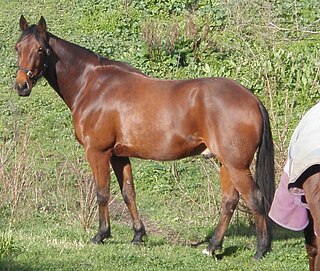
The Standardbred is an American horse breed best known for its ability in harness racing where they compete at either a trot or pace. Developed in North America, the Standardbred is recognized worldwide, and the breed can trace its bloodlines to 18th-century England. They are solid, well-built horses with good dispositions.
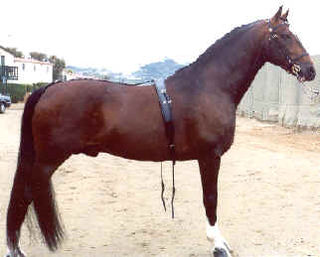
The Hackney is a recognized breed of horse that was developed in Great Britain. In recent decades, the breeding of the Hackney has been directed toward producing horses that are ideal for carriage driving. They are an elegant high stepping breed of carriage horse that is popular for showing in harness events. Hackneys possess good stamina, and are capable of trotting at high speed for extended periods of time.

The Dales Pony is a British breed of pony or small horse. It originated in, and is named for, the Dales of Yorkshire in northern England. It is one the nine native mountain and moorland pony breeds of the United Kingdom, and belongs to the broader Celtic group of ponies which extends from Portugal and northern Spain to Scandinavia.

The Dole Gudbrandsdal, Dølahest, or Dole is a draft- and harness-type horse from Norway. The Dole Trotter is alternately considered a subtype of the Dole Gudbrandsdal and a separate breed; it is also considered a part of the coldblood trotter type. The Dole Gudbrandsdal is a small draft horse, known for its pulling power and agility, while the Dole Trotter is a smaller, faster horse used for harness racing. The two types were previously commonly interbred, but the studbooks have been separate since 2000 and since 2016 the criteria for entry into the Gudbrandsdal horse studbook has required a strict critique of eligible mares. The Dole is originally from the Gudbrandsdal Valley, and is probably descended in part from the Friesian horse. Over time, the breed has had Thoroughbred, Arabian, and other breeds added in, especially during the creation of the Dole Trotter in the 19th century. The first studbook was created in 1941, and the current breed association was formed in 1947. Although originally used mainly as a pack horse, today, the heavier Dole type is used mainly for agricultural purposes. The Dole Gudbrandsdal been crossed with other breeds to develop horses for harness racing and riding.
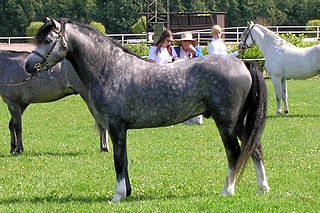
The Welsh Pony and Cob is a group of four closely-related horse breeds including both pony and cob types, which originated in Wales. The four sections within the breed society for the Welsh breeds are primarily distinguished by height, and also by variations in type: the smallest Welsh Mountain Pony ; the slightly taller but refined Welsh Pony of riding type popular as a children's show mount; the small but stocky Welsh Pony of Cob Type, popular for riding and competitive driving; and the tallest, the Welsh Cob, which can be ridden by adults. Welsh ponies and cobs in all sections are known for their good temperament, hardiness, and free-moving gaits.

Messenger was an English Thoroughbred stallion imported into the newly formed United States of America just after the American Revolution. He is most famous for being the great-grandsire of Hambletonian 10, the father of all American Standardbred horses. Though he did not have a long racing career himself, he was a common ancestor in many successful racing horses into the 20th century.
The Colorado Ranger is a horse breed from the Colorado High Plains in the United States. The breed is descended from two stallions imported from Turkey to the US state of Virginia in the late 1800s. These stallions were then bred to ranch horses in Nebraska and Colorado, and in the early 1900s the two stallions who every registered Colorado Ranger traces to, Patches #1 and Max #2, were foaled. The breed was championed by rancher Mike Ruby, who founded the Colorado Ranger Horse Association in 1935. Original registry membership limits resulted in many Colorado Ranger horses being registered instead as Appaloosas, but pedigree research is ongoing to discover additional horses who trace their ancestry back to the original stallions.

Hambletonian 10, or Rysdyk's Hambletonian, was an American trotter and a founding sire of the Standardbred horse breed. The stallion was born in Sugar Loaf, New York, on 5 May 1849. Hambletonian has been inducted into the Immortals category of the Harness Racing Hall of Fame.

Diomed (1777–1808) was an English Thoroughbred race horse who won the inaugural running of the Epsom Derby in 1780. Sold and imported to Virginia, he was subsequently a successful sire in the United States after the American Revolutionary War.

Flying Childers (1715–1741) was a famous undefeated 18th-century thoroughbred racehorse, foaled in 1714 at Carr House, Warmsworth, Doncaster, and is sometimes considered as the first truly great racehorse in the history of thoroughbreds and the first to catch the public imagination.

The Furioso-North Star is a horse breed developed in Hungary at the Mezőhegyes stud farm. Today it is considered a warmblood breed, noted as a breed with a sound, durable build capable of light farm work, yet with a refined appearance that reflects its Thoroughbred influence.
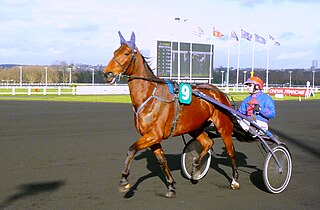
The French Trotter is a French breed of trotting horse bred for racing both ridden and in harness. It was bred specifically for racing in the 19th century (1800s), principally in Normandy in north-western France.

Black Allan or Allan F-1 was the foundation sire of the Tennessee Walking Horse. He was out of a Morgan and Thoroughbred cross mare named Maggie Marshall, a descendant of Figure and the Thoroughbred racing stallion Messenger; and sired by Allandorf, a Standardbred stallion descended from Hambletonian 10, also of the Messenger line.

Gaines' Denmark was one of the most influential stallions in the development of the American Saddlebred.
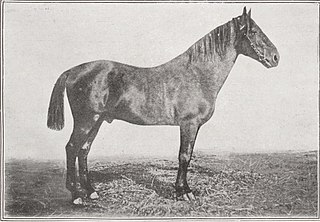
Niger was a trotter horse originated from a lineage of the now-extinct French Trotter breed. A son of The Norfolk Phœnomenon, he was a grandson or great-grandson of the English stallion The Norfolk Phenomenon. His dam, Miss Bell, was a half-blood mare of English or American origin, reputed to have served Napoleon III.

Narquois was a racehorse born in Calvados, an Anglo-Norman trotter. He was one of the first sons of the main stallion behind the French Trotter, the head of the Fuschia breed. Like him, Narquois became an excellent competitor, but at the same time was renowned for his ugliness. He usually competed in pairs with his half-sister, the mare Nitouche.

Phaéton was an Anglo-Norman trotting horse, son of the Thoroughbred The Heir of Linne, considered a founding stallion of the French Trotter breed. An average competitor, Phaéton, a cross between a Thoroughbred and a Norfolk Trotter, made his name thanks to the excellent performances of his offspring during his stallion career at the Haras National du Pin. Phaéton became one of the four great founders of the modern French Trotteur, along with the stallions Normand, Conquérant and Lavater.

The Norfolk Phœnomenon is a black-coated stallion of the Norfolk Trotter breed. He is a son or grandson of the most famous English trotter stallion of his time, The Norfolk Phenomenon. He was imported to France in 1851 on a mission from the Haras Nationaux.

Corlay (1872-1897) was a stallion close to the Thoroughbred, head of the Corlay horse breed, considered in his day to be one of Brittany's most famous and influential stallions. The history of this sturdy roan horse is steeped in legend. It is generally accepted that he was the son of Flying Cloud, a Norkfolk Trotter stallion imported from England to Brittany in 1864, and a local three-quarter Thoroughbred mare, Thérésine.



















